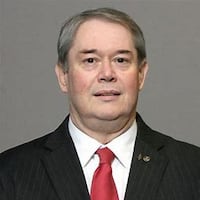On Wednesday, most of the chairs in the waiting area were filled.
“The demand is not down,” Maxwell said. “The demand is very strong.”
Earlier this month, The Greater Cincinnati United Way set a goal of bringing 10,000 residents out of poverty by 2021. Of those, between 1,500 to 2,000 live in the Middletown area, said Terry Sherrer, executive director of the local United Way.
While he called it “a very lofty goal,” he said the community can’t let the daunting task deter them.
For a city to be vibrant, its residents can’t be impoverished, he said.
“Our role is to help lift up those who are willing to be lifted,” Sherrer said, adding that the initiative isn’t about more welfare.
The United Way is contacting agencies, businesses, churches and residents to discuss ways to improve the financial picture of the community, he said.
Montana Sweezy never thought she’d need assistance. She and her husband, Christopher, work full-time, but at the end of the month, there isn’t enough money to pay the bills.
So she packs up her daughters, ages 2 and 4, and drives to Family Service of Middletown. They leave with enough groceries and clothes to get them through the month.
“What are we supposed to do?” she asked in the parking lot. “I mean, honestly, I feel bad coming to places like this because I feel like I should be able to support my kids.”
She works second shift at a gas station, her husband, Christopher, works first shift at a plastic fabrication company in Franklin. Still, they need assistance.
“I never thought I’d need assistance having a job, plus my husband having a job. I still have to come here for help to support my kids,” she said.
Their two-bedroom apartment costs them $700 a month.
As a last resort, she started a GoFundMe account when she got behind on her bills.
“That makes me feel even worse about it,” she said.
One key for residents getting out of poverty is education, Maxwell said. He said there are high-paying jobs in the region going unfilled because the applicants don’t have the necessary skills. He said that’s surprising since Middletown is home to Miami University Middletown and Cincinnati State.
“People need to be better prepared for the opportunities,” he said.
Another issue may be a lack of coordination among the city’s social service agencies, said Karin Maney, executive director of the Community Building Institute of Middletown.
Credit: DaytonDailyNews
Maney said Community Building Institute of Middletown works with 35 partner agencies in Middletown, but there is no one organization that coordinates those efforts.
She said there needs to be some coordination to eliminate duplication of services.
She said creating a “virtual navigator” app that could ask the right questions would be very beneficial for people trying to find information and assistance and decreasing that sense of hopelessness and frustration of trying to find the right agency and services to address their needs.
In addition, Maney would like to see representatives from Ohio Means Jobs and Butler County Jobs and Family Services come to Middletown to work with people needing assistance who cannot travel because of transportation issues.
Jeff Diver, executive director of Supports to Encourage Low-income Families, agreed there is a need to get all of the agencies together to share resources and ideas.
“We can’t be in silos,” he said.
A recent community forum hosted by the Community Building Institute of Middletown discussed the psychological impacts of poverty and the challenges created in promoting upward mobility.
One of the forum’s speakers — Mintu Bachann — is the producer of the documentary film “Replicating a J.D. Vance Anomaly.”
The documentary explores how Vance overcame adverse childhood experiences while growing up in Jackson, Ky., and in Middletown.
Bachann said the creation of his start-up nonprofit Middlelayers was inspired by Vance’s story and his book, “Hillbilly Elegy: A Memoir of a Family and Culture in Crisis.”
Through strong family, community and school influences, Vance learned the value of education as the key to lift himself from a low-income, working class family to become a successful venture capitalist and author, Bachann said.
Bachann’s nonprofit organization — Middlelayers — wants to pilot a technology solution to help people identify and access social and other community services more efficiently.
“Poverty is colorblind,” Bachann said. “There are plenty of examples of black and Hispanic success stories. J.D.’s experience can be replicated to everyone if they want to. The community helped to create and increase the social capital for upward mobility.”
City Manager Doug Adkins said there are a lot of programs in the community to assist people. He also said there people who are underemployed but cannot receive the training or certifications to earn a better paying job because of childcare or transportation issues.
Successful efforts to address poverty and penetrate a mentality of hopelessness must be collaborative, holistic, and understanding of the circumstances in which people live, Adkins said. He also said not everyone gets exposed to opportunities and said there is a need to build a sense of community.
“Poverty has its own culture and lifting families out of poverty takes faith, community resources, education, reliable child care, transportation and job opportunities,” he said. “Only when all of those needs are simultaneously and continually met will families see ongoing success.”


